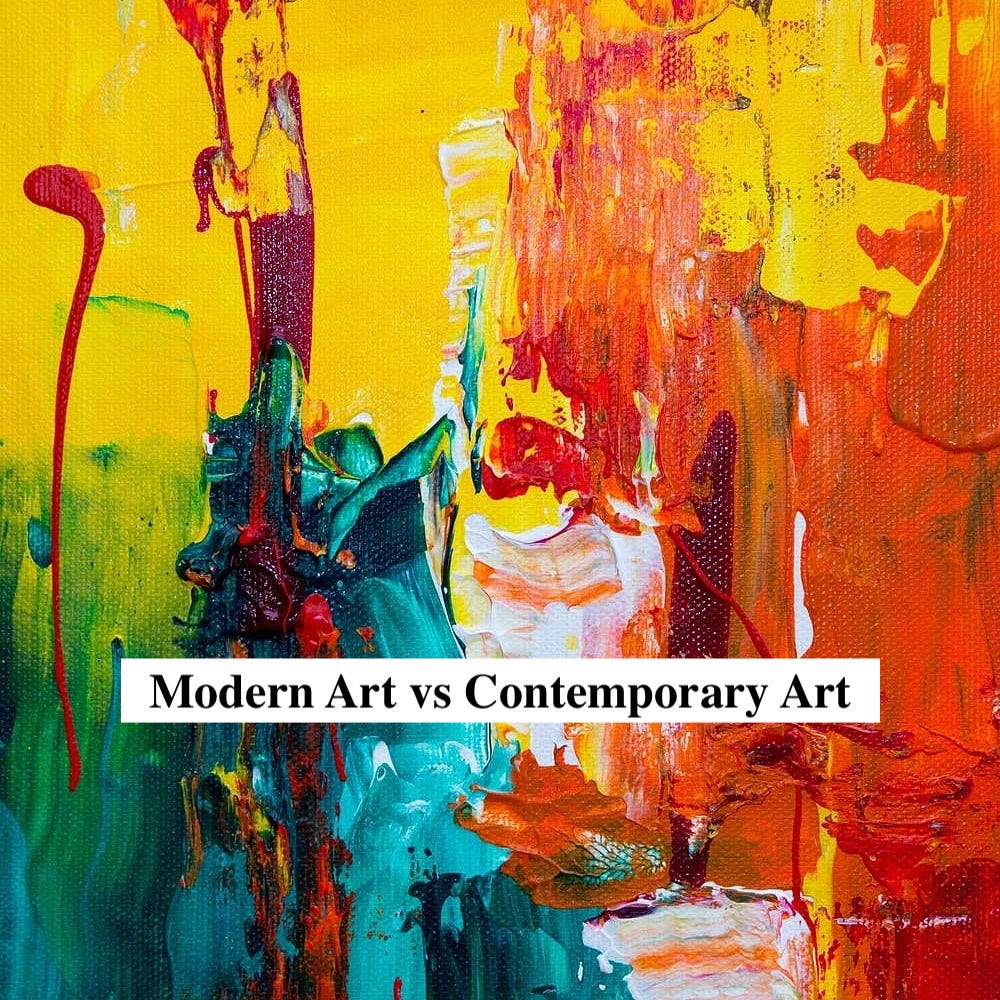Alright, folks, imagine you’re strolling through an art gallery, sipping on your latte, and pondering life while gazing at some mind-bending artwork. Suddenly, you start wondering, “What’s the deal with Modern Art and Contemporary Art? Aren’t they kinda the same thing?” Well, my art-loving friend, you’re not alone in that thought bubble.

So, here’s the lowdown in simple, everyday words. Modern Art and Contemporary Art might sound like they’re in the same creative club, but they’re actually the cool kids from different generations. Let’s break it down:
Modern Art: Picture this—back in the late 19th century and early 20th century, artists were like rebellious teenagers breaking free from the old artistic traditions. They were all about experimenting with new styles, materials, and ideas. You know those famous artists like Picasso, Van Gogh, and Dali? Yep, they’re the poster children of Modern Art.
Modern Art is like your great-great-grandma’s vintage vinyl records. It’s historical, iconic, and laid the foundation for the art world’s crazy journey. Artists from this era wanted to challenge the norms, embrace abstraction, and express themselves in fresh, exciting ways. Cubism, Surrealism, and Abstract Expressionism were the cool cliques in this artistic high school.
Contemporary Art: Fast forward to today, and you’re smack dab in the world of Contemporary Art. This era kicked off in the late 20th century and is still going strong. It’s like the rebellious grandkid of Modern Art. Contemporary artists are all about reflecting the here and now, like holding a mirror up to our modern lives.
You’ll find everything and the kitchen sink in Contemporary Art. It’s like an artistic buffet—you’ve got paintings, sculptures, installations, digital art, and even performance art. And guess what? Contemporary artists aren’t afraid to mix and match styles, borrow from the past, or throw in a political or social message.
So, what’s the real difference? Modern Art is like your grandparents’ stories—it’s about the past, history, and those iconic pioneers. Contemporary Art is like your friend’s Instagram feed—it’s all about the current moment, diversity, and pushing boundaries.
let’s dive deeper into the fascinating world of Modern Art vs. Contemporary Art.
Modern Art Revisited:
Imagine it’s the late 19th century. The world is undergoing rapid changes due to industrialization, urbanization, and the seismic shifts in society. Artists of this era, like Vincent van Gogh, Pablo Picasso, and Claude Monet, were like pioneers exploring uncharted creative territories.
1. Break from Tradition: Modern artists broke away from the traditional, realistic styles that had dominated art for centuries. They were done with the status quo and decided to turn art on its head.
2. Experimentation: This was the era of experimentation. From Cubism (Picasso’s fragmented masterpieces) to Impressionism (Monet’s dreamy landscapes), artists were like mad scientists, testing new techniques and approaches.
3. Historical Context: Modern Art was shaped by significant historical events like World War I and World War II. The chaos and upheaval of these times deeply influenced artists, leading to powerful and often abstract expressions of the human experience.
Also see: Famous Art Movements and Their Impact on Modern Art
Contemporary Art Explored:
Fast forward to the late 20th century, and you’re in the realm of Contemporary Art. The world has changed dramatically again, thanks to technological advances, globalization, and evolving social dynamics.
1. The Present Moment: Contemporary Art is all about the “now.” Artists in this era aren’t looking back; they’re capturing the current zeitgeist. Whether it’s a commentary on our digital age or a reflection of multiculturalism, it’s about addressing contemporary issues.
2. Diversity: One of the standout features of Contemporary Art is its inclusivity. Artists from diverse backgrounds, cultures, and perspectives are celebrated. You’ll find art that explores identity, politics, gender, and much more.
3. A Fusion of Mediums: Unlike Modern Art, which often focused on specific styles (like Cubism or Abstract Expressionism), Contemporary Art is a melting pot of mediums. You’ll see paintings, sculptures, installations, performance art, digital art, and anything else an artist can dream up.
4. Globalization and Technology: Thanks to the interconnectedness of our world, artists can draw inspiration and collaborate globally. Technology has also opened up new avenues for artistic expression, from digital art to interactive installations.
5. Challenging Boundaries: Contemporary artists aren’t bound by convention. They’re constantly pushing boundaries, whether it’s through unconventional materials, thought-provoking concepts, or controversial themes.
Also see: Contrasting Impressionism and Expressionism: A Study of Artistic Movements
The Real Difference:
So, what truly sets Modern and Contemporary Art apart? It’s the context and spirit of the times. Modern Art encapsulates the radical changes and artistic revolutions of the early 20th century. Contemporary Art, on the other hand, reflects our modern, complex, and ever-evolving world.
Think of Modern Art as the foundation—the rebellious teenager who paved the way. Contemporary Art is the present-day embodiment of creativity, diversity, and boundary-breaking. Both are invaluable chapters in the epic story of human artistic expression.
Next time you wander through an art gallery, you’ll not only appreciate the stunning visuals but also the historical and societal contexts that gave birth to these remarkable creations. Enjoy your journey through the captivating realms of Modern and Contemporary Art!